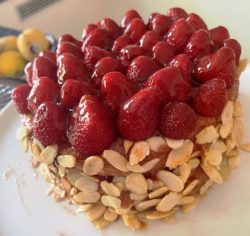Read Time: 4 Minutes Subscribe & Share
A Who’s Who
 M.F.K Fisher – check. Elizabeth David – check. Laurie Colwin – probably a check. And who hasn’t read about or read something that Julia Child wrote. But very few know about Dione Lucas or own one of her cookbooks. And yet, she preceded these culinary icons in presenting classic French cuisine to the American public in classes, restaurants, cookbooks and TV shows.
M.F.K Fisher – check. Elizabeth David – check. Laurie Colwin – probably a check. And who hasn’t read about or read something that Julia Child wrote. But very few know about Dione Lucas or own one of her cookbooks. And yet, she preceded these culinary icons in presenting classic French cuisine to the American public in classes, restaurants, cookbooks and TV shows.
Born in 1909, as a British citizen, her adult life was shaped in the crucible of World War II. Before the war, Dione, still in her late teens, was the first woman to garner the “Grand Diplome” from Henri Paul Pellaprat, the founding chef of the Cordon Bleu cooking school in Paris. She later founded the Cordon Bleu Cooking School in London with Rosemary Hume. The two partners were forced to curtail the school and its restaurant during the London Blitz.
During the war, Dione Lucas, was evacuated to Canada as a young mother with two boys (0ne born with cerebral palsy), while her architect husband stayed behind in the UK to work on Britain’s bomb shelters. She later stayed with relatives in New York City. Once ensconced in Manhattan, Dione Lucas ran a series of restaurants (The Egg Basket was one in which she singlehandedly created omelets for clients). She taught classes and wrote several cookbooks. She even had a cooking show on television, predating WGBH’s blockbuster “The French Chef.” The producer was a woman, Frances Buss Buch, who gave a charming and revealing interview that has been preserved by the Television Academy Foundation.
created omelets for clients). She taught classes and wrote several cookbooks. She even had a cooking show on television, predating WGBH’s blockbuster “The French Chef.” The producer was a woman, Frances Buss Buch, who gave a charming and revealing interview that has been preserved by the Television Academy Foundation.
Dione often talked about her work in the kitchen of a hotel restaurant in Hamburg, Germany, where Adolph Hitler dined on her squab preparation (so much for his being vegetarian) — a claim her older son contested. She considered cooking an art form and became cranky when having to answer food science questions. She also launched a new design in knives, inspired by Japanese kitchen cutlery. Many considered Lucas difficult and dour, traits that may have been caused by long bouts of migraines that were most likely treated with heavy doses of narcotics. Still, to have accomplished all this as a single mother with a son hospitalized frequently (she and her husband divorced, and he left for England with the other son) Dione Lucas deserves to be recognized for her achievements.
A Different Biscuit
I purchased The Gourmet Cooking School Cookbook some time in the late 1960s, as I had an aunt who had gone to a cooking school in Paris (she told me that as a debutante in her day, you went to Paris and you took cooking lessons). She would invite me over on occasional Saturdays and we would cook lunch together. She taught  me my first basics of classic Frenchcuisine and introduced me to the wonders of Lapsang Souchong tea and vermouth in the afternoon. While the book has many recipes that are clearly quite fussy and take up several pages, Lucas has a few less strenuous gems that I still make today. Her
me my first basics of classic Frenchcuisine and introduced me to the wonders of Lapsang Souchong tea and vermouth in the afternoon. While the book has many recipes that are clearly quite fussy and take up several pages, Lucas has a few less strenuous gems that I still make today. Her Biscuit Milanaise Aux Fraises is one of them.
Biscuit Milanaise Aux Fraises is one of them.
I posted this cake on Instagram a few weeks ago, and the number of requests for the recipe truly surprised me. It is an unusual approach to an Italian sponge cake. I have made it in both a 7-inch pan and an 8-inch pan. The latter will obviously give you a slightly flatter cake – it is the classic European cake that is split into two layers, in contrast to American versions that bake in two separate layer cake pans. You can make the sponge cake a day ahead, and then do the rest the next day. I tried substituting cornstarch for the potato starch, so you don’t have to make the same mistake. I use a strawberry jam made by Rigoni Di Asiago in Italy that I get at Mom’s rather than the raspberry or currant jelly she recommends. The combination of strawberry with wild strawberries in this spread makes an intensely flavored glaze


- 2 eggs (each should weigh 2oz or 57gr)
- 2 egg yolks and reserve the whites
- 8oz wt (227gr) caster sugar
- 2oz wt (57gr) all purpose white flour
- 2oz wt (57gr) potato starch
- pinch fine sea salt
- grated rind of 1 lemon
- For the filling and top with decoration
- 3 1/2 cups fresh strawberries (828ml) - 1 1/2 cups (355ml) to be sliced and 2 cups (473ml)kept whole for the top.
- 1 teaspoon lemon juice.
- 1/3 cup (79ml)strawberry spread (as noted in text, she used strained raspberry or red currant jelly)
- grated rind of one lemon
- 12 additional ounces (340gr) of strawberry spread - or her choice of red currant or raspberry jelly
- 1 tablespoon dry sherry or Madeira - I use kirsch or grappa
- 1 cup (237ml) sliced almonds, lightly toasted.
- Preheat oven to 350F (178C) and brush a 7x3 inch (18x8cm) springform with melted butter and dust it thoroughly with flour - you can use an 8 inch (20cm) pan as well, it will just not rise as high as the smaller one)
- I also use almond powder or flour for dusting pans instead of flour.
- Add the eggs, yolks, caster sugar, flour and potato starch in your mixer bowl with a pinch of salt.
- With the whisk attachment, turn the mixer on to medium speed and beat for at least 8-10 minutes; you want to achieve a light and very fluffy mixture.
- In a separate bowl, whisk the egg whites to the soft peak stage.
- Fold these into the batter and then fold in the grated lemon rind.
- Pour the batter into the prepared springform, leveling the top.
- Place the pan on top of a sheet pan and bake for 35-45 minutes - I look for 200F on my Thermapen.
- The cake should more than double in volume and the top should spring back lightly to your touch.
- Remove the cake from the oven and slide a thin knife around the edge of the pan to loosen the cake.
- Turn out the cake on a cake rack to cool.
- When it has cooled, slice the cake in two layers horizontally.
- Add your 1 1'2 cups sliced strawberries in a bowl and add the teaspoon lemon juice, grated lemon rind and the 1/3 cup of strained jam or spread of your choice.
- Mix these together gently and spread on the cut side of the bottom layer of the cake.
- Replace the top half of the cake.
- Pour the 12 ounces of strawberry spread or red current or raspberry jelly into a saucepan and add the liqueur of your choice.
- Warm this mixture and then strain through a sieve into a bowl
- When it is cool, carefully brush it completely over the top and the sides of the cake.
- (I make sure that the sides are generously coated as it makes it much easier to pat on the sliced almonds)
- I place the cake on plate and then pat the sliced almonds on the sides, picking up with the side of my hand the fallen ones and pressing against the glaze — a litle fiddly but doable.
- Cover the top with the whole strawberries - I do it in concentric circles, sort of.
- Brush the remaining glaze on top of the strawberries.
- She suggests that it can be done with sliced peaches or apricots, in which case you would use apricot jam instead of a red fruit one.
- Sometimes I pipe the base and top edge with rosettes of whipped cream when I’m feeling fancy.

Kitchen Detail shares under the radar recipes, explores the art of cooking, the stories behind food, and the tools that bring it all together, while uncovering the social, political, and environmental truths that shape our culinary world.




My mother used her cookbooks and recipes before anyone had heard of Julia Child, so when the TV show came on air, a lot of what Child was discussing was what we had been avidly devouring for some time! Going to Dehillerin’s kitchen supply house was always one of her favorite places to visit in Paris; the ensuing crate that arrived weeks later always had mysterious devices that we would have to decipher, since back in the early 60’s these things didn’t come with instructions.
Hello Daphne,
I loved the story about your mother and shopping at Dehillerin! I was surprised how many people who love French cooking did not know about Dione Lucas.
Nancy